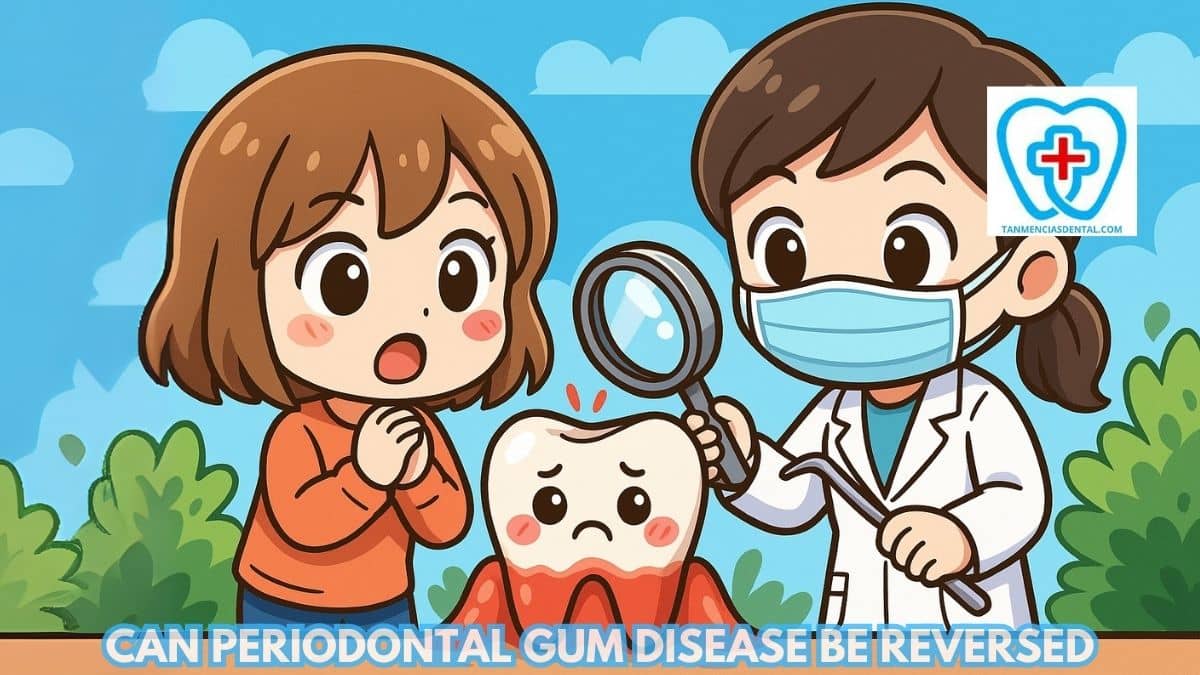Many people wonder, “Can periodontal gum disease be reversed?” because gum problems are so common.
Gum disease affects the tissues that hold teeth in place and can cause lasting problems if ignored.
The condition can range from mild gum swelling to serious bone damage.
Knowing what stage the disease is in makes a big difference in how it is treated.
We’ll explain what can be reversed and what can only be managed.
1. Definition And Stages Of Gum Disease
Gum disease is a common problem that starts when sticky plaque made of bacteria builds up on teeth and gums.
If this buildup is not removed, the gums become swollen, tender, and may bleed easily, which is the first stage called gingivitis.
Gingivitis is the mildest form of gum disease and can often be reversed with proper care.
If it is ignored, it can progress to periodontitis, a more advanced stage of periodontal disease.
Periodontitis affects the deeper layers of gum tissue and can damage the bone that supports teeth.
At this stage, teeth may loosen, gum pockets may deepen, and the risk of tooth loss increases.
Each stage of gum disease requires a different treatment plan, from simple cleaning to more complex procedures.
The longer the disease is left untreated, the more serious and permanent the damage can become.
🦷 Basic Dental Care and Routine Dental Care: Understanding the Difference
2. Reversibility Of Early Gum Inflammation (Gingivitis)
Gingivitis is the only stage where it is possible to reverse gum disease fully because the bone and deeper tissues are still healthy.
At this stage, the gums may bleed during brushing, appear swollen, or feel sensitive, but the supporting structures around the teeth are not yet damaged.
Good oral care, such as brushing twice a day and flossing, can usually remove the plaque that irritates.
Professional dental cleaning helps remove hardened deposits that brushing alone cannot reach, speeding up the healing process.
With these steps, gums can return to a firm, healthy state in a short period of time.
If early signs are ignored, gingivitis can progress into a more advanced form of gum disease that cannot be completely reversed.
🦷 Are Electric Toothbrushes Safe and Effective for Children?
3. Importance Of Early Detection And Treatment
Detecting gum disease at an early stage greatly improves the chances of protecting long-term oral health.
Dentists are trained to notice warning signs such as gum redness, swelling, and bleeding gums that may not seem serious at first.
These signs show that the gums are under stress and need attention before the condition gets worse.
If a dentist confirms gum disease, they can design a treatment plan that matches the stage and severity of the problem.
Acting early can stop the disease from spreading to the bone and deeper gum tissue.
Patients who receive care right away often avoid the need for surgical procedures or complex treatments later.
Early treatment also makes it easier to reverse gingivitis, the mildest stage of gum disease.
Taking timely action allows gums to heal and helps patients maintain healthier teeth for the future.
🦷 Treating Gingivitis in Toddlers: A Practical Guide for Parents
4. Daily Oral Hygiene Practices
Cleaning teeth twice daily removes plaque before it hardens into tartar.
Flossing clears the tight spaces between teeth where brushing cannot reach.
Rinsing with a mild mouthwash can lower bacteria and reduce swelling.
Using a soft-bristled toothbrush helps protect gums from further irritation.
These habits lower the risk of gum disease returning after treatment.
🦷 How Sedation Dentistry Helps Patients Manage Dental Anxiety
5. Professional Dental Cleaning And Scaling
Professional dental cleaning is important because it removes plaque and tartar that regular brushing and flossing cannot reach.
When buildup collects under the gumline, it can irritate gum tissue and lead to disease if not treated.
Scaling and root planing is a deeper procedure where the dentist carefully cleans below the gums and smooths the tooth roots.
This smoothing makes it harder for bacteria to stick and helps the gum tissue heal more effectively.
Patients with a higher risk, such as those with early signs of periodontitis, may need this treatment more often.
Regular professional care supports the gums in reattaching to the teeth after inflammation.
By keeping the roots and gum areas clean, the mouth has a better chance of staying healthy long-term.
🦷 Keeping Your Teeth Clean With Braces: Simple Tips That Work
6. Advanced Treatments For Severe Gum Disease
When gum disease becomes severe, more intensive care is needed.
Root planing smooths the surfaces of tooth roots, making it harder for bacteria to cling.
In some cases, surgery is required to clean deep pockets or repair damaged tissues.
Dentists may also prescribe antibiotics to control infection.
These treatments do not reverse all harm but help stop the condition from worsening.
🦷 Should You Brush Before Using Teeth Whitening Strips?
7. Limitations In Reversing Bone Loss
Once gum disease destroys the bone that supports teeth, the lost bone cannot grow back naturally.
As the bone weakens, teeth may start to feel loose and less stable in the mouth.
Gum recession often develops at this stage, which makes teeth appear longer and increases sensitivity.
Some dental surgeries, such as bone grafts, can restore small areas of support, but these procedures are not always successful for everyone.
Severe cases may lead to tooth loss if the disease continues without control.
Treatment at this point focuses on stopping further damage and protecting the remaining bone and gum tissue.
This is why it is important to recognize gum disease early, before bone loss becomes permanent.
🦷 Do You Need to Brush After Teeth Whitening? Here’s the Answer
8. Impact Of Lifestyle On Gum Health
Habits play a major role in how gums heal and stay healthy.
Smoking reduces blood flow to the gums and slows healing.
Stress can weaken the immune system, making it harder for the body to fight bacteria.
A diet rich in fruits, vegetables, and vitamins supports strong gums and teeth.
Choosing healthier routines greatly improves the chances of controlling gum disease.
🦷 Why Do You Have a Bad Taste in Your Mouth After Brushing?
9. Regular Dental Checkups And Monitoring
Routine dental visits are important because they allow professionals to check the health of your gums and teeth over time.
Dentists often measure the pocket depth around your teeth, which shows how well the gums are healing or if the disease is still active.
These visits also help detect small issues before they turn into more serious problems that are harder to treat.
Patients with gum disease are usually advised to return every three to six months for cleaning and monitoring.
During these appointments, the dentist can adjust care recommendations based on how the gums respond.
Regular monitoring gives the best chance of keeping the gums stable and protecting the teeth from future damage.
🦷 Prosthodontic Dental Care in Marikina: What You Should Know
10. Long-Term Gum Disease Management And Maintenance
Managing gum disease requires a lifelong commitment to care.
Even after treatment, bacteria can return if cleaning is not consistent.
Daily brushing, flossing, and periodic professional cleanings are essential.
Patients must follow the schedule recommended by their dentist to maintain results.
Long-term care keeps the disease under control even when full reversal is no longer possible.
🦷 Dependable Dental Clinic in Marikina
👨⚕️ Conclusion
The answer to “Can periodontal gum disease be reversed?” depends on the stage of the condition.
Gingivitis is reversible, but advanced periodontitis can only be controlled, not cured.
Professional treatment, combined with careful home care, makes a significant difference in outcomes.
Lifestyle choices and routine dental visits also play a strong role in keeping gums healthy.
Early action is the key to protecting teeth and gums from permanent harm.
😊 Self-Promotion
Looking for trusted dental care in Marikina?
Visit us at Tan-Mencias Dental Clinic, located at 44 G. Del Pilar Street, Parang, Marikina City.
Our friendly team is ready to help you with your dental needs and make every visit comfortable.
You can reach us by calling 0917-145-1074, sending a message through our Facebook page, or using the contact form on our website.
We’re always here to answer your questions and give you the care you deserve.
❔ FAQs
1. What are the first signs of gum disease?
The first signs include red or swollen gums, bleeding when brushing or flossing, and bad breath that does not go away.
Some people may also feel tenderness or notice their gums pulling back from the teeth.
These early changes are usually a sign of gingivitis, which can be reversed with proper care.
2. Can gum disease go away without treatment?
Gum disease will not go away on its own.
Gingivitis may improve with better brushing and flossing, but professional cleaning is often needed to fully remove plaque and tartar.
If left untreated, the disease can progress and cause permanent damage.
3. How often should I visit the dentist if I have gum disease?
Most people with gum disease should see their dentist every three to six months.
These visits help track gum health, clean areas that are hard to reach at home, and stop the disease from getting worse.
Your dentist may suggest more frequent visits depending on your condition.
4. Can bone loss from gum disease be reversed?
Bone loss caused by gum disease cannot grow back naturally.
Some dental procedures, like bone grafting, may restore small areas, but results can vary.
The main goal of treatment is to prevent further bone loss and keep remaining teeth stable.
5. What can I do at home to help prevent gum disease?
Brushing teeth twice a day, flossing daily, and using a mild mouthwash help lower the risk.
Eating a balanced diet and avoiding smoking also improves gum health.
Good home care, combined with regular dental visits, gives the best protection against gum disease.

